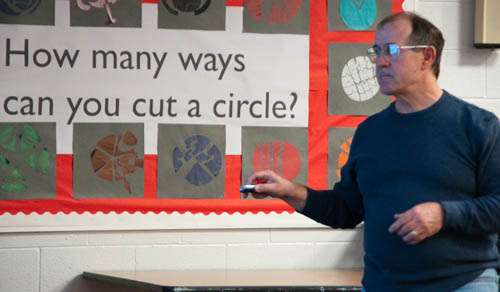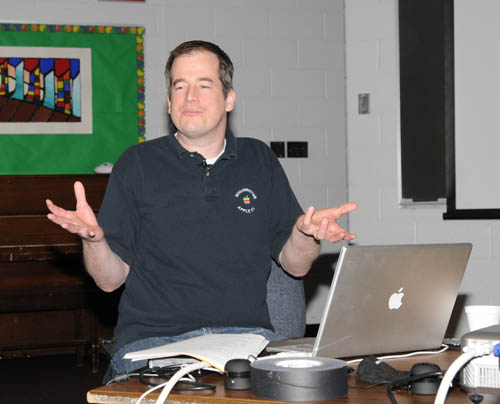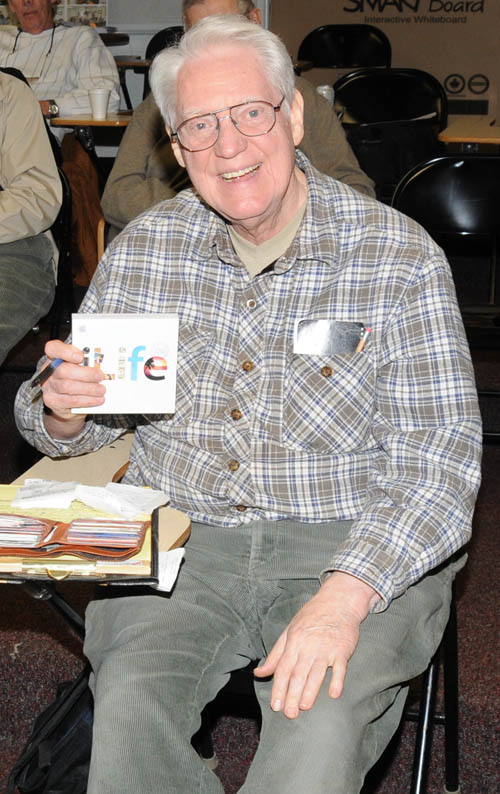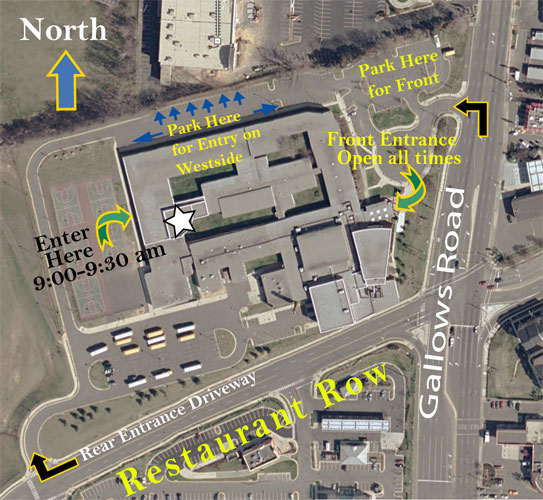



Meeting photos by Richard Sanderson | Meeting photos by Lawrence I. Charters
Just a few days after income taxes were due, the April Pi General Meeting offered something less onerous, but not necessarily less taxing: movie making. Every Mac, for several years, has shipped with everything needed to make movies on a Macintosh. Technically, you don’t even need a camera; some very clever movies have been made using nothing more than the titling capabilities and special effects that come with iMovie. But where to begin?
Steve Roberson, head of Zurka Interactive in Alexandria, VA, outlined an almost effortless technique for making movies during the main presentation. But first, there were –
Q: How many of you own an iPhone? How many own an iPod touch? How many own
neither?
A: About a third in the audience of 50-plus owned neither an iPhone nor an
iPod touch. Amazing.
Q: What’s the rumor I’m hearing that they’re going to upgrade
Mac OS X again?
A: Yes, there is such a rumor. Apple has announced that the next version
will be called Snow Leopard. What is the difference between Leopard and Snow
Leopard? Snow leopards are much more rare…
Apple has talked quite a bit about Snow Leopard, but at the same time been stingy with details. What is known: Snow Leopard will offer few new “features,” but instead concentrate on core technologies. For example, Apple has stated they will make a major effort to improve security, and has hired a number of the leading security gurus to, presumably, work on security.
Snow Leopard will also be 64-bit, and still be backward compatible with 32-bit applications. In theory, this means you could have 16 terabytes (16 trillion bytes) of RAM, which might be adequate even for Photoshop. It will come with QuickTime X, which presumably will do something cool. It will support Microsoft Exchange 2007 for Apple Mail, Address Book and iCal, as well as everything Mail, Address Book and iCal currently support. It will have even better support for multiple processors and multi-core processors.
One of the most interesting capabilities is support for OpenCL. Open CL will allow Mac OS X to use advanced video cards for computational purposes.
Taken as a while, it sounds like Snow Leopard will be much the same as Leopard, but much faster and more secure.
Q: Will Snow Leopard require an Intel-based Mac?
A: Apple hasn’t said one way or the other. But just reading the tealeaves,
it sounds like it will be Intel-only. It would be much easier to do many
of the things Apple says it is doing if it were Intel-only. But they haven’t
said.
[At the June Apple World Wide Developer Conference, Apple did state that Snow Leopard would require an Intel-based Mac.]
Q: I’m thinking about moving from Microsoft Word to Pages.
What problems will I run into?
A: Pages is a superb page layout package. It isn’t as full
featured as Word, and if you have been using Microsoft Word since
1984 and understand how it works, Pages seems limiting and, at times,
somewhat slow. On the other hand, Word is loaded with a whole bunch
of specialized functions most mortals never use, such as Track Changes, an
essential tool for government bureaucrats. Track Changes, with its random
auto-corruption feature, is something you won’t find in Pages (thankfully),
and is something most people won’t miss, either.
For most people, Pages is a great word processor. If you aren’t writing a massive novel, if you aren’t writing a heavily indexed document, Pages is outstanding. Pages also works with Mac OS X services, allowing you, for example, to have Mac OS X’s text-to-speech capabilities read out loud whatever you have written.
Q: What about going back and forth between Pages and Word?
A: You can go back and forth between Pages and Word fairly
effortlessly, though all the effort is on the part of Pages. Pages ‘09 (and,
in Mac OS X 10.5, TextEdit) can read Word 2003, Word
2004, Word 2007 and Word 2008 files, and can export
files in Word 2004 format.
There are problems with heavily formatted Word files, complete with tables, illustrations and whatnot. Pages displays the Word document in a way that it understands, which may not be the same as it looks in Word itself. But if you aren’t working for a government agency, or an organization that thinks Word is a database, a spreadsheet, and a project management package, Pages has no problem with reasonably normal Word documents.
Q: Can a Word user easily open up a document created in Pages?
A: No, Word can’t open a Pages document. Pages can
export a document in Word format, but if the formatting is particularly
complex (text flowing around graphics, background images, etc.), it probably
will not look right in Word.
In addition to Pages capabilities, Keynote, bundled with Pages as part of iWork ’09, can open up PowerPoint 2003, 2004, 2007 and 2008 files, and write PowerPoint 2003 files. Keynote is far, far more useful and easier to use than PowerPoint. When you toss in iWeb ’09, iWork ’09 is a better value for most Mac users than Office 2008 – unless you work for the government, or a corporation that insists on using Microsoft Office.
Q: I have a whole bunch of stuff done in AppleWorks and ClarisWorks,
including word processing documents, spreadsheets, databases and drawings.
I now have a Mac running Leopard. What can I run that will read these files?
A: Export as many of these documents as possible as .doc (Word format)
files, tab-delimited files (which can be read by FileMaker, Excel,
and Numbers), and other modern formats. Apple stopped all work on AppleWorks and ClarisWorks in
1999. The original AppleWorks dates back to 1984, and was written
for the Apple II. Apple Corporation has officially declared all of this to
be history, and has discontinued all support.
Pat Fauquet notes that Pages can, with some success, read some AppleWorks and ClarisWorks documents, but if at all possible, export these documents from AppleWorks or ClarisWorks into a modern format, and then migrate the exported files to iWork ’09, Microsoft Office, or FileMaker, depending on the type of document.
Q: My girlfriend has just been appointed to head a very large online health
care project. She has never used a Mac, but her son and I have both tried
to get her to switch. She is open to the idea, but is afraid that using a
Mac might be a problem since all the computers at work are Windows.
What can I tell her?
A. First, this particular project will have high security concerns, and generally
speaking, “Windows” and “security” don’t go
well together. Second, most of the data used in the government – word
processing documents, slides, spreadsheets – are not operating system
specific; Microsoft Office works just as nicely on a Mac as it does
under Windows. Third, when you are talking about online projects,
such projects must, of necessity, be operating system and browser agnostic:
they really shouldn’t care what browser you are using, and don’t
know what operating system your computer is using. There really aren’t
any problems in moving back and forth between a Mac and a Windows machine.
Another thing to keep in mind: if an organization is Windows-only, that organization must change away from whatever they are using in any case. Windows NT, Windows 95, Windows 98, Windows Me, Windows 2000, and Windows XP are all either out of date and unsupported or at end of life. Microsoft recently advised large clients to stop migrating people to Windows Vista; it, too, is being pushed to the side in favor of Windows 7, which doesn’t exist yet. So change is coming no matter what, and she might as well change to a stable platform: Mac OS X.
Q: I have a lot of E-mails from my PC friends that come with attachments
that end in .wmv. I can’t open them up. What are these?
A: A .wmv file is a Windows Media File, usually a video file. There are a
number of ways to do this. One is to install Flip4Mac. It comes
in several flavors, a free version that allows you to view most .wmv
files, and a variety of increasingly expensive commercial versions that allow
you to export QuickTime files to .wmv and various other tricks.
The second option – if you just want to view files – is to install VLC, an open source, cross-platform multimedia player. VLC is highly recommended, as it does not interfere with existing software on your Mac.
Q: For Windows Media Files, can’t you just use Microsoft’s Windows
Media Player for Mac?
A: Microsoft has completely abandoned Windows Media Player for Mac.
It hasn’t been updated in several years, and it cannot play anything
produced by the last several versions of Windows Media Player. Microsoft
explicitly recommends Flip4Mac; most Mac techies recommend VLC.
After the Q & A, Bob, the Pi President, covered various topics that fell under the general theme of Good News and Bad News.
The not so pleasant topics included the shortage of nominees for the soon to be open Board of Director's positions, something the club has to deal with on an annual basis. Bob explained there was a fall back option of appointing Directors into open positions, but it still couldn't happen without the necessary person agreeing to be on the Board. The second disappointing news was that the next edition (May 1) of the Journal was going to be delayed due to unavailability of some of the key editors of the publication.

President Robert Jarecke aims his phaser at the enemy... Photo by Lawrence I. Charters
Bob moved on to the more pleasant news. First there was an encouraging report on the Pi Photo Contest that was in progress. Bob encouraged everyone to get out there and take those winning images! He predicted a great awards event at the May 30 General Meeting. Next, Bob covered the upcoming Pi events and the calendar was going to be full in the month of May. Along with the normal Special Interest Group (SIG) and other meetings, the Pi was hosting Dr. Mac on May 16 at Luther Jackson Middle School. Also, it was pointed out that the Pi would be moving the May General Meeting to George Mason University. If it is received well, this may become a new, more comfortable setting for our monthly gatherings.
To close out the short presentation session, Bob asked for questions and one lone hand went up. The inquiry was about the inactive Tuesday Night Clinic program and when it would return. Bob sympathized with the member's desires to have it available again, but could not offer any information other than that the project’s champions were still searching for a compatible location. He did promise that as soon as there was a change, it would be announce far and wide; keep checking your email and the Pi Web site!
Given the subject, it was appropriate that the general meeting was filmed (though without film) as an experiment. Two digital video cameras were employed to record the sights and sound, with one generally focused on the screen and one on the speaker. Periodically the film crew (Pi members) interrupted the proceedings to talk about various problems (video or audio cables too short, ran out of room on a tape, forgot to switch on the external mike, etc.) encountered during the taping, and the interruptions were sometimes as enlightening as the presentation. One lesson was very clear: longer presentations are much harder to tape than shorter ones, and live events are much harder than pre-scripted events.
Steve Roberson’s presentation, however, had a different set of lessons: easy steps to making wonderful short films using iMovie ’09. He included slides (available on the Pi Web site, in QuickTime or PDF), still photos, digital video, and iTunes-based music in his presentation, all of which are a bit difficult to reproduce in a narrative. His understated sense of humor and whimsy are equally difficult to capture in print. But the themes were clear.
OK, maybe iMovie isn’t that old, but it has come a long way from the first version. The most recent incarnation is a cross between iMovie HD of 2006 and Final Cut Express: an extremely powerful suite of tools for turning video clips, sounds, music, special effects and titles into complete short films that look shockingly professional, and with minimal effort. The great experiment, iMovie ’08, which most people didn’t use, has been reborn with the best elements of the original iMovie, plus some technology borrowed from the more expensive (and complex) Final Cut Express. The result is a set of tools of surprising subtlety and power, yet quite easy to use.
Even easier if you’ve bothered to read the help files, or followed Steve as he made a film from scratch, while the audience watched. He took some pre-recorded clips of his family, demonstrated how to crop them to show the best of the best, arranged them in order, and brought in some still images to add additional perspective.
One of the more intriguing segments involved GarageBand. He took a piece of music, broke it down by beat (GarageBand makes this easy), and then matched a slide show of still images and video clips (can video clips be “slides?”), and then set it all to music. The result brought gasps from the audience: it was endearing, it was quick, and there was no magician hidden behind the curtain. All you need is iLife ’09, some music, some photos, some video, and an idea.

Steve Roberson tries out a Gallic shrug when asked about preferences in movie making technique. Preferences are up to the individual; a certain amount of planning, and an understanding of your audience, on the other hand, are universal. Photo by Richard Sanderson.
Along the way, Steve demonstrated some less than obvious elements of iMovie ’09, such as Precision Editing, which allows you to make very, very precise adjustments to sound and video. While Steve demonstrated video stabilization, and admitted the results are eye-popping, he confessed it wasn’t as useful as many other more mundane enhancements.
He listed some recommendations for making good movies:
Steve spent a short amount of time on some cool special features in iMovie ’09, such as green screen effects, picture-in-picture effects, and transferring iMovie projects to Final Cut, which is the industry standard for professional digital video. But this was frosting; his goal was to show how easy it was to put together a short video clip, and he succeeded admirably.
Prior to the One More Thing segment of the meeting, we held a raffle for a copy of Apple's iLife '09 application suite. With the use of our own Programming SIG's creation, the Raffler program, the winning number was selected. After a lengthy period of uncertainty, Dail Doucette finally acknowledged that he had the winning ticket. He gratefully accepted the shrink-wrapped prize and posed and grinned as Dick Sanderson took his picture for posterity (and this Journal).

Dail Doucette won a copy of iLife ’09 at the April General Meeting just after watching a superb demonstration of the package. Photo by Richard Sanderson.
As for One More Thing: Travis Good conducted a brief, yet comprehensive tutorial on how to use iWeb ’09 (part of iLife ’09) to quickly and easily populate your member Web site. Pick a template. Drag in movie clips and photos. Type in some text. Add a link or two. And upload it to members.wap.org. It’s easy. The accompanying graphic (Figure 1) lists the five steps.
Figure 1: Travis Good condensed the five easy steps to publishing using iWeb on the Pi’s member server in the right sidebar: 1) Fire up iWeb and select New Site; 2) Fill in the required fields; 3) Test your connection (to see if you filled in the fields correctly); 4), Add content, and 5) Publish the site. Click on the image for a larger view.
To show how easy it was, he took some photos of the meeting audience, added some text, and uploaded his mini-Web site, in a matter of minutes.
SIG (Special Interest Groups) following the meeting included the Genealogy SIG, with four attendees, Members Helping Members SIG with one attendee, iLife SIG with ten attendees, and the iPhone and iPod Meet Up with a varying number (since some of these attendees also attended other SIGs). Given that the General Meeting was off schedule (a week early, due to room conflicts), it was a fair turnout, and you can’t improve on the one-to-one ratio for the Members Helping Members SIG.
VLC media player:
http://www.videolan.org/vlc/
Flip for Mac:
http://www.telestream.net/flip4mac-wmv/overview.htm
The main event will feature a presentation by Steve Roberson, a club favorite, as he reveals some of his secrets on making great movies. From the beginning frame to the final credits, Steve will show us how to take a piece of music, photos and digital video, and with a little imagination, produce a Sundance award winner.
Of course, if anyone attending has some special techniques, hints or short cuts, pipe up and pass them along to everyone. The more the merrier, and it will serve to make this a great event.
Questions and Answers will lead off the day followed by Club business, which will include the introducing of the nominees standing for election to the Pi Board. Kitty’s Koffee Klatch comes next with hot coffee and doughnuts.
After the main presentation, we will conduct a raffle drawing for a copy of iLife ’09. The lunch break will feature our usual pizza fare. Special Interest Group sessions and other meetings will round out the day.
Check the Web site again closer to the meeting for any last-minute
details. See you there!
Note: best to park where the blue arrows are located.

Questions: Contact the WAP office at (301) 984-0300.
The meeting, open to the public, starts at 9:30 a.m.